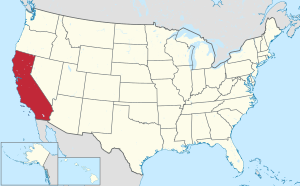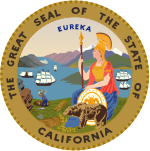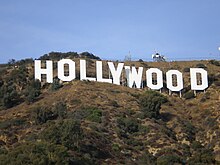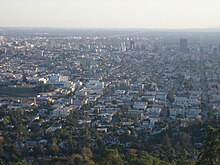California
California | |
|---|---|
| Nickname: Golden State[1] | |
| Motto: | |
| Anthem:"I Love You, California" | |
 Map of the United States with California highlighted | |
| Country | United States |
| Before statehood | Mexican Cessionunorganized territory |
| Admitted to the Union | September 9, 1850 (31st) |
| Capital | Sacramento[1] |
| Largest city | Los Angeles |
| Largest metroandurbanareas | Greater Los Angeles |
| Government | |
| •Governor | Gavin Newsom(D) |
| •Lieutenant Governor | Eleni Kounalakis(D) |
| Legislature | State Legislature |
| •Upper house | State Senate |
| •Lower house | State Assembly |
| Judiciary | Supreme Court of California |
| U.S. senators | Laphonza Butler(D) Alex Padilla(D) |
| U.S. House delegation |
|
| Area | |
| • Total | 163,696 sq mi (423,970 km2) |
| • Land | 155,959 sq mi (403,932 km2) |
| • Water | 7,737 sq mi (20,047 km2) 4.7% |
| • Rank | 3rd |
| Dimensions | |
| • Length | 770 mi (1,240 km) |
| • Width | 250 mi (400 km) |
| Elevation | 2,900 ft (880 m) |
| Highest elevation | 14,505 ft (4,421.0 m) |
| Lowest elevation | −279 ft (−85.0 m) |
| Population (2020) | |
| • Total | 39,538,223[5] |
| • Rank | 1st |
| • Density | 253.6/sq mi (97.9/km2) |
| • Rank | 11th |
| •Median household income | 71,228 |
| • Income rank | 5th |
| Demonym | Californian |
| Language | |
| •Official language | English |
| •Spoken language | |
| Time zone | UTC−08:00(PST) |
| • Summer (DST) | UTC−07:00(PDT) |
| USPS abbreviation | CA |
| ISO 3166 code | US-CA |
| Traditional abbreviation | Calif., Cal. |
| Latitude | 32°32′ N to 42° N |
| Longitude | 114°8′ W to 124°26′ W |
| Website | www |
| California state symbols | |
|---|---|
 | |
 | |
| Living insignia | |
| Amphibian | California red-legged frog |
| Bird | California quail |
| Fish |
|
| Flower | California poppy |
| Grass | Purple needlegrass |
| Insect | California dogface butterfly |
| Mammal |
|
| Reptile | Desert tortoise |
| Tree | Coast redwood&giant sequoia[7] |
| Inanimate insignia | |
| Colors | Blue & gold[8] |
| Dance | West Coast Swing |
| Folk dance | Square dance |
| Fossil | Sabre-toothed cat |
| Gemstone | Benitoite |
| Mineral | Native gold |
| Rock | Serpentine |
| Soil | San Joaquin |
| Sport | Surfing |
| Tartan | California state tartan |
| State route marker | |
 | |
| State quarter | |
 Released in 2005 | |
| Lists of United States state symbols | |
California,officially theState of California,is astatein the western part of theUnited States,along thePacific Ocean.
It is the third biggest US state byarea(afterAlaskaandTexas) with 163,696 square mi (423,970 km2). It hasmore peoplethan any other state with over 39 million people as of 2020. It also has more people thanCanada.Its largest cities areLos Angeles,San Diego,San Jose,andSan Francisco.The capital isSacramento.The states around its borders areArizonato the southeast,Oregonto the north,Nevadato the east, and theMexicanstate ofBaja Californiato the south.
Geography
[change|change source]California, which has a North/South orientation, has a wide range of climates.
Thegeographyof California varies depending on the region. Southwestern California has small mountain ranges and the cities of San Diego and Los Angeles. Southeastern California has the Mojave Desert andDeath Valley,the lowest place in the United States. The eastern part of the state has the highest point in the United States outside of Alaska:Mount Whitney,in theSierra Nevadamountain range.[9]
The cities of Sacramento,Bakersfield,andFresnoare in theCentral Valley.The valley has theSierra Nevadato the east and the Pacific Coast Ranges to the west. It is California's single most productiveagriculturalregion and one of the most productive in the world. It produces more than half the fruit, vegetables, and nuts grown in the United States.[10]More than seven million acres (28,000 km2) of the valley areirrigatedby an extensive system ofreservoirsandcanals.[11]
The west-central part of the state has some small mountains and the cities of San Francisco, San Jose, andOakland.Northern Californiahas theCascade Range,theKlamath Mountains,and the Modoc Plateau.[12]Far northern California does not have many people, but the San Francisco region and the Sacramento region are often thought of as part of northern California.
Climate
[change|change source]Flora and fauna
[change|change source]California is home to many animals such asracoons,the California condor, and themountain lion.California’s official flower is the California poppy. California was once home to theGrizzly bearand thejaguar.California poppyis the official flower of California.
Culture
[change|change source]

The state is a leader in three businesses:farming,movie-making, andhigh technology,mostlysoftwareandwebsites.Aerospaceused to be a large industry there, but it has been downsized in the last 20 years.
California is very diverse. Today it has high numbers ofHispanic and Latino Americans,Asian Americans,andArmenian Americans.
There are manyearthquakesin California. They happen when two tectonic plates (parts of the Earth's crust) shift underground. Californians need to be prepared for earthquakes and often store extra food, water, flashlights, and first aid supplies in case of such an emergency.
California has more people than any other state in the United States. If California was a separate country, it would have the sixth largesteconomyin the world. California is probably the state with the most ethnic groups. It also has many different geographic features – mountains, deserts, and coasts. It is often calledThe Golden State.The state flower is the golden poppy. Thepost officeuses "CA" as a shorthand for California, and theAssociated Pressuses "Calif." or "Cali."
California has a large population ofMexican Americans.Mexican Americans have influenced Californian cuisine and Californian culture. California also has a large Filipino, Vietnamese, Korean, Japanese, Indian, and Chinese population. There aren't as many white people in the state but there are still many Russian, Spaniard, German, English, Scottish, Portuguese, Italian, Dutch, Irish, and French people in the state. Other ethnic groups in California are Serbians, Persians, Bulgarians, Navajos, Cherokees, Nicaraguans, Alaskans, andRomani people.
California is popular among celebrities. Celebrities such asKim Kardashian,Dwayne Johnson,Kylie Jenner,andJennifer Anistonare from California.
California Englishis a dialect of the English language spoken within California. California is the home to a highly diverse populace, and this is reflected in many other languages, especially Spanish. As is the case of English is spoken in any state, not all features of California English is used by all speakers in the state, and not all features are restricted in use only to the state. However, there are some linguistic features which can be identified as either originally or predominantly Californian.
California is famous forIn-N-Out Burger,which is the regional chain of fast food restaurants and founded in 1948 by Harry and Esther Snyder.[13]
ProtestantismandCatholicismare the most practiced religions in California. A smaller population are Jews, Muslims, Hindus, and Buddhists.
Marijuanabecame legal in 2016.
Californian cuisine is influenced by Spanish cuisine, Mexican cuisine, and Asian cuisine.Mexican foodis very popular in California.
California is popular for its tourism.HollywoodandDisneylandare popular tourist destinations in California. Most tourists in Los Angeles come from Mexico, China, Canada, Australia, the United Kingdom, Japan, Vietnam, South Korea, France, Germany, Scandinavia, Middle East, and most recently, India, Spain, Italy, and Southeast Asia.
Politics
[change|change source]In 2019,Gavin Newsombecame thegovernorof California. Before him, the governor wasJerry Brown.
On November 4, 1992,Dianne Feinsteinbecame one of California's United Statessenators.On January 3, 2017,Kamala Harrisbecame the other one. In the2020 presidential election,Kamala Harris was elected as the first woman and person of color to beVice President of the United States.
In January 2021,Alex Padillabecame the next U.S. Senator, replacing Harris, and became the firstHispanicU.S. Senator from the state.
California was more conservative during the 1960s and 1980s when its former governor,Ronald Reagan,ran for president as aRepublican.Today, California is more liberal and less conservative.
History
[change|change source]The people in Coastal California wereNative Americans.The original Californians were a diverse population, separated by language into as many as 135 distinct dialects. Tribes included the Karok, Maidu, Cahuilleno, Mojave, Yokuts, Pomo, Paiute, and Modoc. In the past, the area that was called "California" was not just today's California. This area covered theMexicanlands south of it, as well asNevada,Utah,and parts of Arizona andWyoming.The Spanish called the part of the land that later became part of the United StatesAlta California(Upper California) when it was split from what becameBaja California(Lower California). In these early times, the borders of theSea of Cortezand the Pacific coast were not well known, so the old maps wrongly showed California to be an island. The name comes fromLas sergas de Espladián(Adventures of Spladian), a 16th-century book by Garci Rodríguez de Montalvo, where there is an island paradise called California.
The firstEuropeanwho visited parts of the coast, Juan Rodriguez Cabrillo, came fromPortugalin 1542. The first European who saw the entire coast was Sir Francis Drake, in 1579, and he decided that theBritishowned it. But starting in the late 1700s,Spanishreligious leaders of theRoman Catholic Church( "missionaries" ) got large gifts of land in the area north of Baja California, from the Spanish king and queen. These religious people set up small towns and villages, the famous California Missions. When Mexico was no longer controlled by Spain, the Mexican government took over the villages, and they soon became empty.

In 1846, as theMexican-American Warwas starting, some Americans in California hoped to create a CaliforniaRepublic.These men flew a "Bear flag" that had a golden bear with astaron it. This Republic ended suddenly, however, when Commodore John D. Sloat of the United StatesNavysailed intoSan Francisco Bay.He said that California was now part of the United States. After the war with Mexico ended, California was split between the two countries. The Mexican portion became the Mexican states of Baja California Norte (north) and Baja California Sur (south). ( "Baja" means "lower" in Spanish.) The western part of the part given to the United States became today's state of California.
In 1848, there were about 4,000 Spanish-speaking people in today's California on the American side. (Today the state has a total of nearly 40,000,000 people.) In 1849, gold was suddenly found and the number of people went up very fast as theGold Rushtook hold.Slaveryalso spread there as people hoping to find gold brought African slaves and either forced them to work ingold minesor hired them out for other work.[14]In 1850, California became a state in the Union (the United States).
During theAmerican Civil War(1861-1865), many people in California, especially in the southern part of California, thought the South was right and slavery should be protected. Some people in Southern California even wanted Southern California to leave the rest of the state and join theConfederate States of America.However, this did not happen. California joined the war to and helped the North (the Union) and sent many troops east to fight theConfederacy.[15]
At first, travel between the far west and the east coast of the United States was dangerous and took a lot of time. Going by land was very difficult, because there were no roads and no trains, and manyNative Americanswere attacking American people heading West in wagons. The only other way was to travel by boat around theCape Horn,at the southern end ofSouth America.This took months, since the trip was thousands of miles long and thePanama Canalhad not yet been built either. But in 1869, the connection got better quickly, because the firstrailroadacross the continent was finished. Meanwhile, more people in California were learning that the land there was very good to grow fruit and other crops.Orangeswere grown in many parts of California. This was the beginning of the huge farming business that California has today.
Economy
[change|change source]The economy of the State of California is the largest in the United States. It has agross state product(GSP) of US$3.0 trillion as of 2020.[16]It has many sectors. The most dominant arefinance,business services,governmentandmanufacturing.If California were a sovereign nation, according to 2019 statistics, it would rank as the world's fifth largest economy, lying betweenGermanyandIndia.[17][18]Over 10% of theFortune 1000companies were based in California in 2018.[19]
Present day
[change|change source]In 1900, there were only a million people in California and 105,000 in Los Angeles. Today, California has more people than any other U.S. state. Starting in 1965, the variety of people became much greater as many different people from around the world came to the United States and often decided to live in California. California is thought to be a veryliberalstate, but there are still a lot of people who areRepublicansand viewRonald Reaganas a hero. Technology is very advanced and many new cultural trends begin there.Engineeringandcomputersplay a big part in the state's life. For over a hundred years,filmhas been one of the most important businesses in California. By the 1950s,televisionhad also become an important business in California. Many Latinos especially Mexicans and Salvadorans live in the state.
In the twenty-first century, droughts and frequent wildfires attributed to climate change have occurred in the state.[20][21]From 2011 to 2017, apersistent droughtwas the worst in its recorded history.[22]The 2018 wildfire season was the state's deadliest and most destructive, most notablyCamp Fire.[23]
California has a growing Hispanic and Asian population. White people are the second largest ethnic group in California. Hispanics surpassed the white population in the 2010s.
Although air pollution problems have been reduced, health problems associated with pollution have continued. The brown haze that is known as "smog"has been substantially abated thanks to federal and state restrictions on automobile exhaust.[24][25]
In 2021, the number of Hispanic and Latino residents in California had surpassed the number of white residents, with about 15.75 million Hispanics compared to 13.4 million white residents.
References
[change|change source]- ↑1.01.1"California".www.americaslibrary.gov.RetrievedJuly 3,2020.
- ↑2.02.1"Chapter 2 of Division 2 of Title 1 of the California Government Code".California Office of Legislative Counsel.RetrievedFebruary 23,2019.
- ↑The summit ofMount Whitneyis the highest point in theContiguous United States.
- ↑"USGS National Elevation Dataset (NED) 1 meter Downloadable Data Collection from The National Map 3D Elevation Program (3DEP)—National Geospatial Data Asset (NGDA) National Elevation Data Set (NED)".United States Geological Survey.September 21, 2015. Archived fromthe originalon March 25, 2019.RetrievedSeptember 22,2015.
- ↑"Population, Population Change, and Estimated Components of Population Change: April 1, 2010 to July 1, 2020 (NST-EST2020-alldata)".census.gov.United States Census Bureau.Archivedfrom the original on December 22, 2020.RetrievedApril 26,2021.
- ↑"Languages in California (State)".Statistical Atlas.Archivedfrom the original on August 15, 2018.RetrievedAugust 15,2018.
- ↑"California Government Code § 422".California Office of Legislative Counsel.RetrievedFebruary 23,2019.
- ↑"California Government Code § 424".California Office of Legislative Counsel.RetrievedFebruary 23,2019.
- ↑"The Geography of California".NetState.January 5, 2014.RetrievedJuly 13,2014.
- ↑"California's Central Valley: Producing America's Fruits and Vegetables - House Committee on Natural Resources".Archived fromthe originalon August 5, 2016.RetrievedAugust 4,2016.
- ↑"Federal Agencies Release Data Showing California Central Valley Idle Farmland Doubling During Drought « Landsat Science".[permanent dead link]
- ↑"California Geography".Maps of World.June 5, 2014.RetrievedJuly 13,2014.
- ↑Bowers, Ben (October 27, 2012)."MoB | The History of In-N-Out Burger".Gear Patrol.RetrievedSeptember 22,2022.
- ↑Anderson, Susan (April 2, 2020)."California, a" Free State "Sanctioned Slavery".California Historical Society.RetrievedNovember 15,2020.
- ↑"California in the Civil War".Archived fromthe originalon April 10, 2011.RetrievedMarch 8,2011.
- ↑"Gross Domestic Product by State, Fourth Quarter and Annual 2019"(PDF).www.bea.gov.US Department of Commerce, BEA (Bureau of Economic Analysis).RetrievedJuly 1,2019.
- ↑"Germany GDP - Gross Domestic Product".RetrievedMay 26,2020.
- ↑"Report for Selected Countries and Subjects".International Monetary Fund.
- ↑"Geography of Fortune 1000 Companies in 2018".GeoLounge: All Things Geography.November 13, 2018.RetrievedJuly 2,2019.
- ↑Wilson, Scott (December 5, 2019)."Fires, floods and free parking: California's unending fight against climate change".Washington Post.RetrievedFebruary 8,2021.
- ↑Flavelle, Christopher (September 20, 2020)."How California Became Ground Zero for Climate Disasters".The New York Times.Archivedfrom the original on September 20, 2020.RetrievedFebruary 8,2021.
- ↑"California Facing Worst Drought on Record | NOAA Climate.gov".www.climate.gov.RetrievedFebruary 8,2021.
- ↑"2018 California Wildfires".The United States Census Bureau.RetrievedFebruary 8,2021.
- ↑Deverell, William & Hise, Greg, eds. (2005).Land of Sunshine: An Environmental History of Metropolitan Los Angeles.Pittsburgh, PA:University of Pittsburgh Press.ISBN978-0-82294-254-2.
- ↑Krier, James E. & Ursin, Edmund (1977).Pollution and Policy: A Case Essay on California and Federal Experience with Motor Vehicle Air Pollution, 1940–1975.Berkeley, CA: University of California Press.ISBN978-0-52003-204-0.






